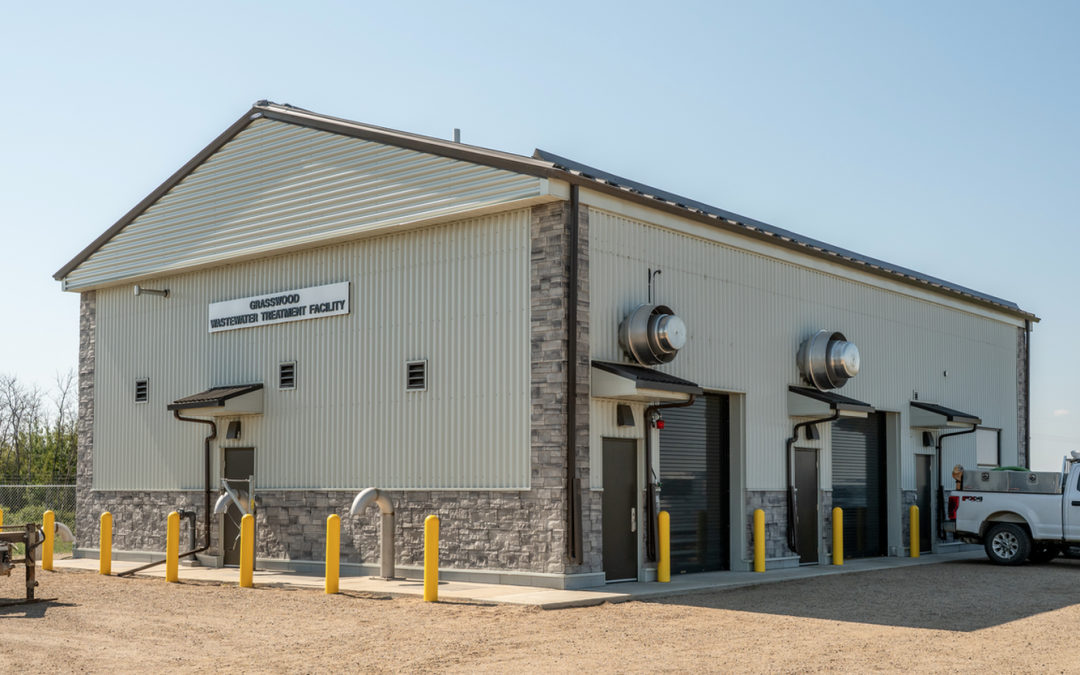Photo: This image shows the Grasswood Wastewater Treatment Facility, which utilizes a Membrane Bioreactor (MBR) that is the first of its kind in Saskatchewan / Photo Submitted
By Kevin Berger
Local Journalism Initiative Reporter
Clark’s Crossing Gazette
Residential, commercial and industrial ratepayers on the south end of the RM of Corman Park soon receive wastewater services through a newly-opened treatment plant that is also a first-of-its-kind facility within the province of Saskatchewan.
Representatives of the RM of Corman Park joined together with members of the English River First Nation (ERFN) and its development arm, the Des Nedhe Group, to mark the grand opening of the Grasswood Water Treatment Facility on Wednesday, August 27.
A release from the Des Nedhe Group indicates they began developing treatment facilities and infrastructure at Grasswood Junction earlier this year. (The actual address for the facility is #1100 – 2555 Grasswood Road East, incidentally.)
The release indicated the wastewater treatment plant was funded through a $27.3 million financing agreement from the Canada Infrastructure Bank.
Speaking at the grand opening ceremony, Des Nedhe president Sean Willy said the treatment plant is currently in operation and crews are working to hook up lines to the building.
Right now, sewage is being trucked in from the south side of Corman Park, but within six months, the plant will be taking in wastewater through pipes from residential developments like Edgemont East.
“This is just the start, right? Saskatchewan’s growing faster than we all think. People are moving here faster than we all believe, and places like this are only going to grow,” he said.
Chief Alfred Dawatzare, who gave comments in both English and the Dene language, said they had purchased the land where the plant is located many years ago, and he was very proud to see something happening with it.
“It took us so many years. A lot of times we took a lot of heat for it at the reserve level, but we know this is going to benefit our reserve,” he said.
Dawatzare encouraged his fellow members of the English River First Nation to talk to the people in their community and tell them what they have here.
He also thanked the federal government, the province and the RM of Corman Park for helping them to push this project to fruition.
“There’s so many people to thank that came together to help us develop this whole thing,” he said. “I strongly believe in partnerships and working together. Working together gets a lot done for us.”
Willy said English River is a very progressive First Nation “that nobody ever hears about,” as they’re not constantly on social media promoting themselves.
“English River’s been leaders within Saskatchewan and the country. They were one of the first to purchase land through TLE (Treaty Land Entitlement). They picked this spot strictly for economic development purposes,” he said.
“What always held us back was the city was never going to build infrastructure this way. They tried … (but) they were going north and they were going east. And so we really had to take matters into our own hands.”
Willy said the initial message was to build a lagoon, but it was eventually decided to create something state-of-the-art that had never been done built before in Saskatchewan.
The end result was a Membrane Bioreactor (MBR) wastewater treatment facility, which utilizes membrane filtration for the separation of solids from the water.
Willy indicated such wastewater treatment set-ups exist in Alberta and B.C., most notably at the Vancouver Convention Centre.
He said that moving people off of septic tanks and fields in South Corman Park will help the environment and also add value to the land in that area.
“Here you have a First Nation supporting the environment, supporting business, supporting the population around us, and allowing everyone to win,” Willy said.
Willy said they were “pleased as punch” that SaskWater came on to this project offering to operate the plant.
Finally, Willy said the RM of Corman Park has been “a great partner,” lauding both the former RM council before the current one and the current reeve, Joe Hargrave.
Noting that he had toured the facility a little while ago, Hargrave himself congratulated English River and Des Nedhe for their accomplishment.
“This facility was needed. Sean’s right: it gets them off the septic fields and gets them using this. It turns this into an urban area,” Hargrave said.
“I’m proud to be a partner with Des Nedhe and working together with Sean on the advisory council. The RM’s happy to be involved here, and we look forward to continuing with this great relationship.”
